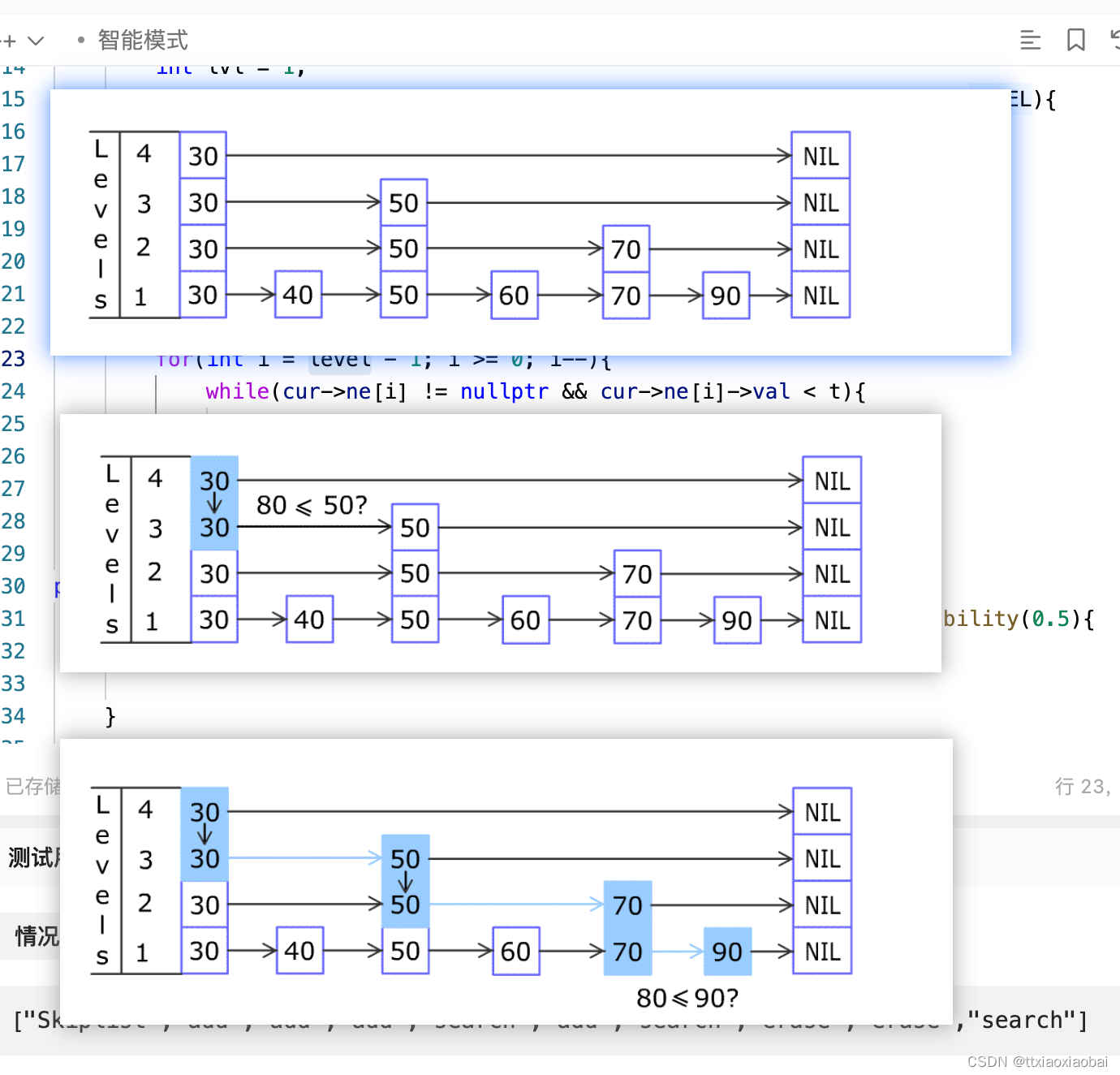跳表
跳表,一种链表数据结构,其增删改茶的效率能和平衡树相媲美
可以看上面的那个动画,动画效果很贴切。
我简单讲讲它的机制吧,每个节点不单单是一个,测试好几层,然后同一层的节点和统一节点的next 采用单链表产生联系
最核心的东西在于find
这也是为什么单链表的增删改查,花费开销最多的地方。

那它是怎么查的?
我们已经知道了跳表的结构了,最底层肯定是最全的,如果暴力最底层,那就和单链表没什么区别了。
它的这个查恰巧结合了跳表的结构,如果在上面某个层找到了节点x 的pre那么接下来的操作都好办了。
那它是怎么找到节点x 的pre呢?
从最上层,依次找该节点的next 知道找到pre 如果在这一层还没找到(因为最后一个节点的next 为nullptr),那么会在这个节点的下一层继续找同层找next。依此类推,最后肯定能找到的。
class Skiplist {
private:
static const int MAX_LEVEL = 10;
struct Node{
int val;
std::vector<Node*> ne;
Node(int _val, int level):val(_val), ne(level, nullptr){};
};
int level;
Node* head;
float probability;
int randomLevel(){
int lvl = 1;
while((float) std::rand() / RAND_MAX < probability && lvl < MAX_LEVEL){
lvl++;
}
return lvl;
}
void find(int t, std::vector<Node*>& ns){
Node* cur = head;
for(int i = level - 1; i >= 0; i--){
while(cur->ne[i] != nullptr && cur->ne[i]->val < t){
cur = cur->ne[i];
}
ns[i] = cur;
}
}
public:
Skiplist() :level(MAX_LEVEL), head(new Node(-1, MAX_LEVEL)), probability(0.5){
std::srand(std::time(0));
}
bool search(int t) {
std::vector<Node*> ns(level, nullptr);
find(t, ns);
Node* target = ns[0]->ne[0];
return target != nullptr && target->val == t;
}
void add(int t) {
std::vector<Node*> ns(level, nullptr);
find(t, ns);
int nodeLevel = randomLevel();
Node* newNode = new Node(t, nodeLevel);
for(int i = 0; i < nodeLevel; i++){
newNode->ne[i] = ns[i]->ne[i];
ns[i]->ne[i] = newNode;
}
}
bool erase(int t) {
std::vector<Node*> ns(level, nullptr);
find(t, ns);
Node* target = ns[0]->ne[0];
if(target == nullptr || target->val != t){
return false;
}
for(int i = 0; i < level && ns[i]->ne[i] == target; i++){
ns[i]->ne[i] = ns[i]->ne[i]->ne[i];
}
delete target;
return true;
}
~Skiplist(){
Node* cur = head;
while(cur){
Node* next = cur->ne[0];
delete cur;
cur = next;
}
}
};
/**
* Your Skiplist object will be instantiated and called as such:
* Skiplist* obj = new Skiplist();
* bool param_1 = obj->search(target);
* obj->add(num);
* bool param_3 = obj->erase(num);
*/
再贴一份,
#include <iostream>
#include <vector>
#include <cstdlib>
#include <ctime>
class Skiplist {
private:
static const int MAX_LEVEL = 10;
struct Node {
int val;
std::vector<Node*> ne;
Node(int _val, int level) : val(_val), ne(level, nullptr) {}
};
int level;
Node* head;
float probability;
int randomLevel() {
int lvl = 1;
while ((float)std::rand() / RAND_MAX < probability && lvl < MAX_LEVEL) {
lvl++;
}
return lvl;
}
void find(int t, std::vector<Node*>& ns) {
Node* cur = head;
for (int i = level - 1; i >= 0; i--) {
while (cur->ne[i] != nullptr && cur->ne[i]->val < t) {
cur = cur->ne[i];
}
ns[i] = cur;
}
}
public:
Skiplist() : level(MAX_LEVEL), head(new Node(-1, MAX_LEVEL)), probability(0.5) {
std::srand(std::time(0));
}
bool search(int t) {
std::vector<Node*> ns(level, nullptr);
find(t, ns);
Node* target = ns[0]->ne[0];
return target != nullptr && target->val == t;
}
void add(int t) {
std::vector<Node*> ns(level, nullptr);
find(t, ns);
int nodeLevel = randomLevel();
Node* newNode = new Node(t, nodeLevel);
for (int i = 0; i < nodeLevel; i++) {
newNode->ne[i] = ns[i]->ne[i];
ns[i]->ne[i] = newNode;
}
}
bool erase(int t) {
std::vector<Node*> ns(level, nullptr);
find(t, ns);
Node* target = ns[0]->ne[0];
if (target == nullptr || target->val != t) {
return false;
}
for (int i = 0; i < level && ns[i]->ne[i] == target; i++) {
ns[i]->ne[i] = ns[i]->ne[i]->ne[i];
}
delete target;
return true;
}
~Skiplist() {
Node* cur = head;
while (cur) {
Node* next = cur->ne[0];
delete cur;
cur = next;
}
}
};
int main() {
Skiplist skiplist;
skiplist.add(1);
skiplist.add(2);
skiplist.add(3);
std::cout << skiplist.search(1) << std::endl; // returns true
std::cout << skiplist.search(4) << std::endl; // returns false
skiplist.add(4);
std::cout << skiplist.search(4) << std::endl; // returns true
std::cout << skiplist.erase(4) << std::endl; // returns true
std::cout << skiplist.search(4) << std::endl; // returns false
return 0;
}
redis
























 223
223











 被折叠的 条评论
为什么被折叠?
被折叠的 条评论
为什么被折叠?








